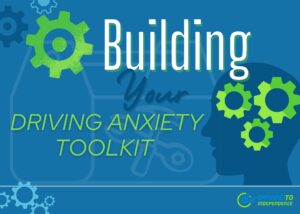
Driving anxiety can be a significant barrier for many individuals, particularly those with disabilities. While understanding the sources of anxiety and its symptoms is crucial, having practical tools and strategies at your disposal can make a world of difference. This blog explores how to create a personalized “driving anxiety toolkit” that can help individuals manage their anxiety and enhance their confidence behind the wheel.
What is a Driving Anxiety Toolkit?
A driving anxiety toolkit is a collection of resources, strategies, and comforting items that individuals can turn to when they feel anxious about driving. By assembling this toolkit, you can prepare yourself mentally and emotionally for the road ahead.
Essential Components of Your Toolkit
Relaxation Music Playlist
Curate a playlist of calming music that you can listen to before and during your drive. Research has shown that music can reduce anxiety levels and improve mood, making it easier to focus on driving. Consider including:
Instrumental Tracks: Choose soothing piano, acoustic guitar, or ambient music to create a tranquil atmosphere. Artists like Ludovico Einaudi or Yiruma can provide calming melodies.
Nature Sounds: Incorporate tracks that feature rain sounds, ocean waves, or forest ambiance. These can evoke a sense of peace and help calm nerves.
Favorite Uplifting Songs: Include songs with positive lyrics or memories attached to them. Creating a personal connection can enhance their soothing effect.
Essential Oils for Calming
Aromatherapy can be a powerful tool for managing anxiety. Essential oils like lavender, hamomile, and bergamot are known for their calming effects. You can enhance your toolkit by:
Creating a Calming Roll-On: Mix a few drops of essential oil with a carrier oil (like coconut or almond oil) in a small roller bottle for easy application.
Portable Diffuser: Invest in a small car diffuser that plugs into your vehicle’s power outlet to disperse calming scents while you drive.
Inhaler Sticks: Use inhaler sticks filled with essential oils that you can take with you to sniff when feeling anxious.
Checklist of Positive Affirmations
Create a list of positive affirmations related to driving. Examples include:
- “I am in control of my driving.”
- “I navigate the road safely and confidently.”
- “Each drive is a step towards greater independence.”
- Write these affirmations on index cards and place them in your car or create a digital version to review before driving.
Driving Journal
Maintain a journal dedicated to your driving experiences. To enhance this practice:
- Daily Reflections: After each drive, note down what went well, any triggers you encountered, and how you felt overall.
- Goal Setting: Set driving goals in your journal, such as specific routes to conquer or distances to increase gradually.
- Progress Tracking: Use your journal to celebrate achievements, no matter how small, to reinforce your growth and resilience.
Emergency Contact List
Include a list of supportive contacts you can call or text if you feel overwhelmed while driving. To enhance this resource:
- Include a “Drive Buddy”: Identify someone you can call for reassurance or assistance if you feel anxious during a drive.
- Have a Quick-Access List: Save important contacts in your phone with quick access so you can reach out without hesitation.
- Text Alerts: Let trusted contacts know you may reach out when driving, so they’re prepared to respond promptly.
Relaxation Techniques Guide
Compile a guide with simple relaxation techniques for use before and during your drive. Consider including:
- Deep Breathing Exercises: Inhale deeply for a count of four, hold for four, and exhale for four. Repeat this several times to calm the nervous system.
- Grounding Techniques: Focus on your senses. Identify three things you can see, two you can touch, and one you can hear while driving to bring your awareness back to the present.
- Visualization Practices: Before starting your drive, visualize a successful journey where you feel calm and confident.
Driving Support Resources
Research and include information about local support groups, driving rehabilitation programs, and mental health resources. To expand this section:
- Local Therapy Centers: Find therapists who specialize in anxiety and driving issues and include their contact information.
- Online Communities: Share links to forums or social media groups where individuals discuss their experiences with driving anxiety, such as the Spinal Cord Injury Peer Support Community or specialized disability forums.
- Professional Organizations: Organizations like Driving to Independence offer specialized training and support for individuals facing driving anxiety, providing resources for personalized guidance.
Conclusion
Creating a driving anxiety toolkit is a proactive step toward managing anxiety and enhancing your driving experience. By incorporating relaxation techniques, positive affirmations, and supportive resources, you can build a toolkit that empowers you to confront and overcome your fears on the road. Remember, the journey to confident driving is ongoing, and at Driving to Independence, we are here to support you every step of the way.
